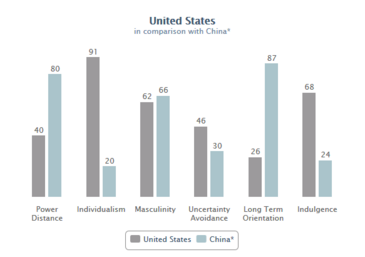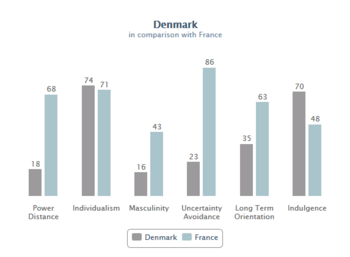International Project Management
Developed by Camille Bortot
Globalization has brought us a more integrated and interdependent world economy and therefore is creating an increasing number of international project, i.e. a project that reach beyond national boundaries regarding either the project purpose or the nationality of the stakeholders. However, surveys show only a 40% success rate of international effort. One would think that standard project management methods can be applied within those projects as it is quite successful on a national scale. But international projects bring many different issues that are not covered by standard methods. One of the most difficult challenge, companies have to undergo is cultural differences. People do not have the same perception of power, happiness, time line or team works and it can have a huge impact on the success of a project. To help the manager identifying those differences, a list of questions have been develop within the Hofstede 6-D method which manages to give a broad idea of the challenges cultural differences could bring. Furthermost, to identify and mitigate all the new issues created by international projects, international project management requires unique methods, tools and techniques.
This article will first deal with the definition of international project management and emphasizes the main differences between international projects and standard projects. A method to identify all the challenges that ensues from international projects will be developed as, depending of the project, you can have quite different issues. Finally, the key success factors in international project management will be exposed.
Contents |
What is an international project ?
General idea
In international project, you have the word project, so of course you can consider it as a directed work that is aimed at achieving specific goals within a defined budget and schedule. However, what’s make International Project different is that it involves multiple locations, entities organizations, and business units.
These are a few examples of what you can consider as international project management :
- A major construction project in another country that involves many subcontractors of different nationalities e.g. Femern Tunnel in Denmark
- Two companies merging their operations e.g. Bayer and Monsanto
- A company deploying a new product in a region e.g. l'Oréal Marketing Plan
- International efforts by governments e.g. War against terror or migration policy
- A major construction project in another country that involves many subcontractors of different nationalities e.g. Femern Tunnel in Denmark
Main characteristics [1]
- Complexity
Those projects have all in common a major characteristic : they are complex projects. In this case, complexity is more due to organizational and geographical causes. The manager is faced to multiple interdependencies and stakeholders spread around the world. He has to find an adequate structure to cope with interdependent interactions but also which enables communication across different time zones. In fact, the complexity of those projects is one of the reason why standard management techniques do not work well.
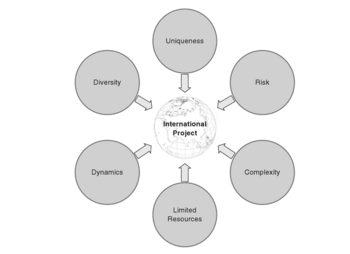
- Risk
Because of this complexity, another characteristic is risk. In most of those projects and especially in the construction field, budget and planning over-runs are expected. It is common in standard projects too, but the factor of uncertainty is much higher in International Project, as political instability in one of the country involved or change of government and a new political line are more likely to happen.
- Uniqueness
International projects have unique objectives and most of the time no former examples to look for. The contexts in which they happened are quite different : countries have different cultures, societal and political structures, technological levels or different attitudes regarding sustainability for example.
- Diversity
Another characteristic of those projects is diversity. Cultural differences are one of the biggest challenges managers will have to face. Organizational structures may differ among the different nationalities represented as well as the languages spoken. Also educational and social backgrounds may have a huge impact on the stakeholders working habits. Therefore, managers have to take into account this diversity.
- Dynamics
They may also face numerous and sudden changes within the project. To take into account the risks or new opportunities that may encounter the project, managers have to take the right decisions quickly. An example in a construction project may be the bankruptcy of a sub-contractors or a new regulation on the construction site.
- Limited resources
Moreover, the larger scope of the project implies also more resources needed especially regarding time for planning, money for transportation and co-ordination efforts. Another limited resource is the staff : it is really difficult to find the staff with the right skills to manage language and intercultural diversity.
All those characteristics show why international projects are different than standard project. Standard management techniques cannot achieve to solve the difficulties involved in international projects especially regarding the scope, the purpose, the main stakeholders and the risk intensity. So that’s why new techniques and tools have to be developed.
Identify the challenges
Cultural awareness in one of the keys to achieve successfully an international project. The Hofstede 6-D model in one of the tools that can be used to identify the different cultural challenges that a company or a manager can encounter during the project.
Hofstede 6-D Model
In his model, Hofstede identified 6 keys areas of cultural differences, hence the 6-D, and so allowed you to make a comparison between two or more countries. Thanks to this tools, you can quickly notice which are the main cultural differences, you can be confront with during the project. To did this, Hofstede decided to score each of the 6 categories on a scale of 0 to 120. [3] [4]
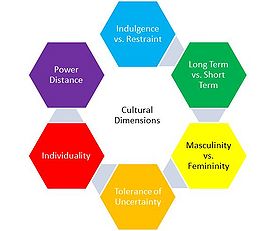
- Large vs Small Power Distance
Regarding of their cultural backgrounds, people have a different acceptance of unequal distribution of power. This difference could have a huge impact on the relationship between two companies and the way meeting are conducted. People in Large Power Distance societies respect a strong hierarchical order often linked to seniority. In the contrary, People in Small Power Distance society will ask for justification of power inequalities and preferred power equal organization.
- Strong vs Weak Uncertainty Avoidance
This is the degree to which members of a society feel uncomfortable about flexibility and sudden changes. It is linked to the acceptance of uncertainty, the way people of a different social background react to ambiguity and the time it takes to them to react on it.Uncertainty avoidance is, in fact, why people tend to believe in institutions which aim to create rules and protect conformity. Strong Uncertainty Avoidance Society does not tolerate deviant or too unconventional attitudes and will not reward innovative people, whereas Weak Uncertainty Avoidance society will just let the future happen and work in a more relaxed atmosphere. In this kind of society practice is more important than rules or theory, it is what make people act well and fast when a sudden change appears. Time, by definition bring uncertainty and this criterion help to understand the reaction of society regarding that fact. Will they try to control it and let small room for risk or will they just let it run its way without any barriers ? Of course, it has a huge impact on the way people build their organizations and instances like Power Distance.
- Individualism vs Collectivism
This mostly concerns the way people think about themselves : is it as a “I” or a “we” ? Individualists think first about themselves and their immediate family. Their own achievement in the company is one of the most important things during their carriers. They are inclined to work against the needs of the group if it means a bigger reward. Collectivism, its opposite, prefers a very tight social network, people will do anything for the team without looking after their personal involvement, but asks in exchange, for unquestioning loyalty. In a society with a high individualism culture, it might be the best solution to engage directly with the key person and allows him to recognize some part of the work as his own success.
- Masculinity vs Femininity
People in a masculine society tend to value achievement, heroism, assertiveness, and material success, whereas in feminine societies, caring for others and quality of life are more important. Moreover, a high masculinity rate means that males dominate a significant portions of the society, they are the leader. The closer you get from the source of power, the higher chance you get to find only male representatives. This will provide societies based on performance. On the contrary, feminine societies strive for minimum social differentiation between the sexes. Men are willing to take modest, caring roles. Those societies even if still showing a high rate of men in their institutions, have a mentality more oriented towards care and quality of life. They are called “welfare societies”. This criterion mostly concerns the self-perception of people and the role they think they have to play in the society.
- Long vs Short Term Orientation
This is the one of the latest dimension added to Hofstede Model. It measures the preferences of the long term horizon over the short term. It can explain to which extent a society shows a belief in absolute truth and conventional or short term point of view instead of having a pragmatic vision oriented toward future perspectives. Long term orientation society will show more perseverance in achieving a task and won’t stick to deadlines and milestones. In the contrary, people from Short term society will look more for personal steadiness and stability and therefore try to fulfil all their obligation on time. They need a very tight framework and a well-planned project.
- Indulgence vs Restraint
We can also add another cultural dimension : Indulgence Vs Restraint. This is basically a measure of the happiness in a society, it is related to the way a person enjoys life and has fun. In a restrained society, gratification will be held back by strict social norms and people are not in control of their emotion and life because the society dictates how they have to behave. In a more indulgent society, people feel free to receive gratification and to express themselves. Social pressure is less important : people can act as they want and therefore really enjoy their life.
Some worldwide results
Thanks to this two diagrams, we can make some useful remarks. For example, both China and France have a high power Distance whereas Denmark has one of the lowest. This means than in France and China there is a strong sense of leadership and respect toward the powerful people, but in Denmark, equality is prevalent. But it is the strong individualism of the French that is strange, because it does not get along with strong Power Distance. This means that even if the French seems to respect hierarchical order and leadership, they think first about their own life and commitment. This can explain why there is so many strikes. In the contrary, American low power distance combine with a high individualism is quite characteristic of their country as they worship liberty. Moreover, regarding masculinity, both Denmark and France have a low score which can be explain by french “welfare state” and Danish culture where men have more responsibilities at home and where quality of live takes a huge place. Regarding Uncertainty Avoidance, both Chinese and Danish have a low rate, so they are comfortable with ambiguity and sudden changes, whereas French needs norm and rule as well as a well-planned structure and activity. Finally, we can say that both American and Danish try to enjoy their life as much as they can and have their own life under control. This is not surprising when we know that Denmark is the happiest country in the world.
Therefore if you have to work with French partners, respect the hierarchical order but give also acknowledgement to the work of individual team members. Moreover, if you have to work with American, take into account their strong individualism. Regarding the Danes, it can shock people from other nationalities to see how low their Power Distance is and it can take time for partners to get used to it. Finally the high Power Distance and collectivism rate of China show that if you interact with the right person, you can be sure that the work will be done. This is, of course, basic remarks but it shows how cultural differences could have a huge impact on interactions between partners on a project.
Implementation of international project management
Once the cultural differences of the project have been identified, it is time to start the implementation of the project. However, due to the cultural awareness, you have to define a specific way of implementation and to pay more attention than usual to some of the steps.
Launch the project
Define the project
As the scope of the project is quite wide and the purpose of such international project are numerous, a good definition of the case is crucial and an approach has to be described. This can seem similar to standard project management but in fact, various steps of the implementation differ due to the characteristics of international project management. [7] [8]
- Measure the current situation
To do this, you have to better understand the process, so you can define the project with greater clarity. With the current situation, you will also help people to understand all the problems and limitations. Finally, you can judge of the validity and necessity of the project. In international project it is a very tricky step as the current situation can evolve really fast depending on the political and social background. - The project concept
Thanks to the background knowledges of the current situation, you can establish the project concept. It means developing the purpose of the project from several point of view, the scope of the project, the roles and responsibilities of stakeholders, availability of resources, the initial issues it will have to faced, the budget and the schedule and the potential benefits. This should give a solid base to your plan. - Define objectives
Then, you have to define the purposes of the project. There is 3 kind of purposes : technical, business and political. The technical purpose relates to the physical activity like IT, construction or distribution. The business purpose is the true purpose of the budget whereas in the technical purpose, you think only about how you can achieve it. The initiators of most of the international project is government so politics is at the core of the project.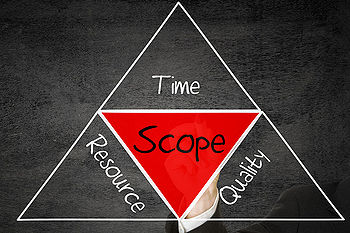 Figure 5 : Define your project scope [9]
Figure 5 : Define your project scope [9] - Determine the scope of the project
You can either look to the dimensions of the project overall each country or look for the impact factors. In the first point of view, you consider thing as number of location, departments involved, extent of system and technology, risk or elapsed time for the project. Regarding the other meaning, impact factors may include cost, benefits, risk and elapsed time for the project. - Establishing roles, responsibilities and resource availability
Once you determine one or two scopes of the project, it can be useful to define the roles and responsibilities of each stakeholder. During this phase, people start to become more excited as they can see the impact of the project on them. Nevertheless, it is a difficult step in Inernational Project as often there is more than one major stakeholder in the project and partners of different nationalities may have the same amount of shares e.g the Coen Tunnel in Amsterdam. Then you may need to also establish the resources needed and all the issues that may impact resource availability. - Estimate costs, benefits and the schedule
This estimation will not be precise but it is a base so that you can work on it afterwards. During this part, you can use experience from your past project to get the better estimation possible at this time of the project. The good communication between the different partners is essential so they can share their experiences and hopes. - Identify the potential issues for the project
Issues can be generating in different fields such as organization, management, system and technology, customers, suppliers and vendors, project work, project staffing and leadership, external factors such as laws, regulation and competition. To identify those issues allows you to discuss how to resolve them during the planning phases and therefore not to wait until they happen. - Determine project interdependencies
An international project tends to be interdependent in many potential ways so you have to identify all those links and how they depend on each other. This is an important tasks if you want to correctly interact with everyone during the project. - Present the project
After collecting all those information, you will have to present the project concept to the stakeholders and reach for their approval. A good idea is to identify two or three possible concept and highlight their advantages and drawbacks so the project leaders manage to get a full overview of the situation.
Identify the Project Leaders
Now that you have define a project concept, it is time to give an attempt on finding the management structure of the project. First, you will be concerned about the number, type and roles of the project leaders for the work and then you move ahead and determine who it should be. [7]

- Management structure
As the project leaders need to have management contacts at both the headquarters and local levels, they may need to be nice and firm at the same time. That’s why it is recommended to have two project leader during an international project : a good guy and a bad guy. To continue in this approach, it is also recommended to have two committees so there is more flexibility for placing management and within the project.
- Characteristics of a project leader
As the leader of an international project, the person you choose for this role will encounter many issues due to the difference between time zones, the long travel around the world, the misunderstanding due to different languages and family pressure for instance. So you must oriented your recruitment regarding some of the most important attributes such as : problem-solving ability, ability to cope in multiple cultures, tenacity and capacity of pursuing issues, good ability of communication, a sense of humor and previous experience in such project. Without those attributes, it will be impossible for your project leader to manage the project.
- Duties of your project leader
To identify the right project leader, you will have to define its duties. Of course, those duties will change within the type of project you want to manage but here are the main domain of activities of the project leader. During the project life, the leader will spend most of his time dealing with issues and opportunities (around 40 to 50 %). Then comes the communication part of his job as he will spend 30-40% of his time speaking with management, team and the other stakeholders of the project. The leader will still be able to do some real work on the project but he has little time for this (around 10-15%). The last activity will be administrative work and this is going to take him 10-20% of his time. This is why solving problem skills and communication skills are so important when you want to pick up your project leader.
Nail Down the Project Organization and Team
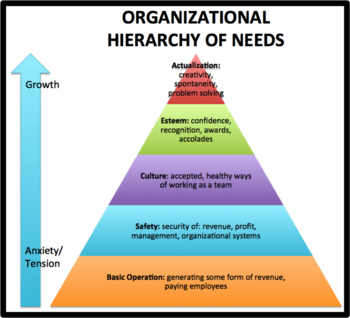
The first thing you have to take care when organizing your project is to identify all the areas of risk and to make sure that a specific member of your team is able to solve it. To do so, you will have to define the team member requirements for success. In an international project there are different kind of team members : critical team members who are essential to the project and are responsible of the interaction between their team and the other one, locally focused team members who only affect part of the project by their work and do not interact quite often with the other team and finally, the cameo members who are in charge of specific and significant tasks within the project but walk out as soon as their role is finished. Of course, most of the abilities required for the project leader is also worthy for his team members but some of the specific skills toward international project management are ability to cope with different cultures, multilingual capacity and willingness to travel for an extended period of time. Finally, a real team mentality have to be built up within the project to guaranty well done job and good relationship among the whole project. [7]
To build this team mentality, another psychological tool can be used : the Maslows Hierarchy of needs. In fact, it could be really difficult to fulfil all the needs of a team especially when all the partners came from different cultural backgrounds. To help fulfil those needs, Maslows hierarchy can be applied to team level rather than individual level. The basic needs to fulfil will be some Basic Operations as to be sure that the team have the basic knowledges to achieve the work e.g in a international construction project, everybody must know the regulation and structural basic rules. Then comes Safety Needs : the team must be free from any mistakes and have to be able to solve any failure that could happen. After this, you also have to take care of the Belonging Needs or Culture Needs which can be the most difficult to fulfil in international project as everyone is also a part of a different company, e.g in a construction project, use meeting to keep all the partners informed of the advancement. The last needs to achieve before addressing growth needs and reaching self-actualization is the Esteem Needs. It can also be tricky to solve this one in an international team as all the stakeholders may have a different perception of individualism and also due to the complexity of the project, everyone can be proud of its achievement and therefore have a greater esteem thanks to it, e.g after the Channel Tunnel, both French and English partners felt that they have success in one of the most challenging project of their time. [12]
Develop the Project Plan
To set up your plan, you will have to divide your project file into management and technical parts. Management file will contain all your cost estimations, budget, actual data, schedules and issues whereas the technical part will regroup the milestone review, the technical end product and a feedback about the lessons learned from the project. This file will serve as a guideline for your project plan.
Then, you will have to use project templates to structure your planning. In this template you will develop the high-level tasks, the general resources assigned to the tasks and the dependencies among tasks as well as all the durations. However, because of its huge size, it is better to split up the overall international project management and create smaller templates for specific activities. Last but not least, the best way to make an international project succeed is to establish the role of a central project coordinator. He is picked up within the project leader and his position switch every six months to create more dynamism. [7]
Key success factors
Even if the project is well-planned and ready to be executed, there is still some crucial factors to look after. Those factors are usually the reasons why an international project fails. [13]
- Communication : even if English is recognized as the project language, there is still misunderstanding especially regarding technical terms.
- IT-Communication and collaboration software : the issue comes not from the availability of the software but from the implementation, active and regular use of it by the different stakeholders.
- General Project management : due to is complexity, international project causes basic project management issues such as staffing availability or resources planning.
- Soft Skills : because of a worldwide distribution, employees are under time and resources pressure but also have to manage the cultural differences, that’s why a team with soft skills is recommended to handle such project.
Limitations
Hofstede’s model is a solid framework to identify the different cultural issues that we can encounter in an international project. It has been widely used in area such as international marketing or finance. However, there are some inconsistencies with this model. This study concentrated one issue at a national scale when there can be huge cultural differences within the same country. This tool has to be carefully used if you want to get result regarding a whole country and not just a few representatives.
Regarding the implementation of an international project, it is good to focus on the cultural differences which is a huge issue but you must not forget the classical management issues which could be quite tricky to solve regarding of the large scope and the worldwide repartition of the project. Sometimes, the simple classic management issue could become a huge problem in an international project such as resource planning or staff allocation. When you want to implement your program it is nice to focus on the specificities of international project but you also have to solve the classical issues.
Furthermore, communication could be a huge issue in International Project, one of the best example for this is the lack of communication between the English and the French teams during the construction of the Channel Tunnel. Even if nowadays, many IT tools exist to help address the geographical gap, different time zones can also be a difficulty. Moreover, those tools such as Skype, common server or cloud, could help to work all together, but according to several studies, nothing is better than a face to face meeting and all the partners of the project have to be aware of that.
References
- ↑ Kathrin Köster, International Project Management, SAGE Publications, 2009, p.12-20
- ↑ Kathrin Köster, International Project Management, SAGE Publications, 2009, Figure 1.5, p.17
- ↑ Geert Hofstede, Cultural dimensions in management and planning, Asia Pacific journal of management, 1984 - Springer
- ↑ Chris O'Halloran, Cultural Dimensions Of International Project Management, http://strikingprojectmanagement.com/cultural-dimensions-of-international-project-management/
- ↑ André de Waal and Kettie Chipeta, The relation between Hofstede’s cultural dimensions and the HPO Framework, http://www.hpocenter.com/scientific-studie/the-relation-between-hofstedes-cultural-dimensions-and-the-hpo-framework/
- ↑ 6.0 6.1 Geert Hofstede Website, https://geert-hofstede.com/countries.html
- ↑ 7.0 7.1 7.2 7.3 Rea, Kathryn; Lientz, Bennet, International Project Management, Taylor and Francis, 2012
- ↑ Kathrin Köster, International Project Management, SAGE Publications, 2009,p.189-219
- ↑ Paul Newton and Helen Bristoll, Managing your Project Scope, http://www.free-management-ebooks.com/news/managing-project-scope/
- ↑ Lindsay Scott, Top Five Skill Areas for a New Project Manager, http://www.esi-intl.co.uk/blogs/pmoperspectives/index.php/top-five-skill-areas-new-project-manager/
- ↑ Virginia Ginsburg, Unstable Organizations Can’t Grow, http://www.womenonbusiness.com/unstable-organizations-cant-grow/
- ↑ Anita Sarma and André van der Hoek, A Need Hierarchy for Teams, 2004
- ↑ Pool2Business, International Project Management,Virtual Collaboration Beyond National Boundaries
Annoted Bibliography
- Geert Hofstede Website
This website gives the whole pannel of the different tools and studies achieved by Geert Hofstede. You can find all the studies realized on Cultural Differences and the improvement made on the first 4-D Model thought by Hofstede. Moreover, you can also have access to tools that allows you to compare two different countries based on the 6-D Model and information collected through the whole world by Geert Hofstede research team. More developed tools for professional and companies are also available and with them you can have a more complete analyse of cultural differences.
- Geert Hofstede, Cultural dimensions in management and planning, Asia Pacific journal of management, 1984 - Springer
It gives a good definition and explanation of Hofstede 6-D model and how to apply it. This is a review of the first 4-D Model thought by Hofstede. It is based on his previous research but with a deeper approach. This is the basic book, if you want to learn more about Cultural Differences and how to identify them. It also show the process Hofstede followed to separate the cultural challenges into 4 then 5 and finally 6 categories.
- Kathrin Köster, International Project Management, SAGE Publications, 2009
An excellent base to learn more about international project as it give a complete definition of this type of project and several templates to help the planning and preparation phases. Thanks to the different templates, this book could be really useful for practitioners who want to implement an international project.
- Rea, Kathryn; Lientz, Bennet, International Project Management, Taylor and Francis, 2012
It gives also a good definition of an international project management but also the characteristics of its implementation. This books is based on Kathrin Köster's work and give a further approach on the implementation aspect with several examples and case studies to show how you can make it works.
- Pool2Business, International Project Management,Virtual Collaboration Beyond National Boundaries
A good survey about the key success factors of international project. It is really well-documented and based on the answer of several stakeholders who have been part on an international project. It is a good feedback on the different issues regarding main important field in project management such as Communication, IT-skills and uses, Global team management... You can also find many diagrams to sum up the answers of the survey which could be used by practitioners afterwards.
- Morris, P.W.G.; Hough, G.H., The anatomy of major projects: a study of the reality of project management, 1987
An interesting book in which you can find several case studies of international project such as the Channel Tunnel Project and the Concorde. A complete analyse for those major projects, their success and failures, is given. This is a good way to know which are the main issues in international project and what has been tried to make them succeed.
